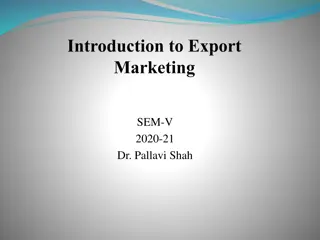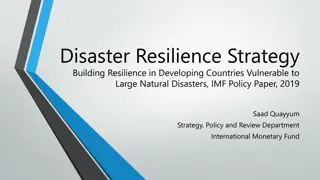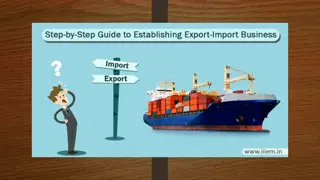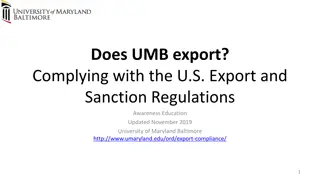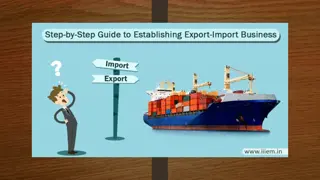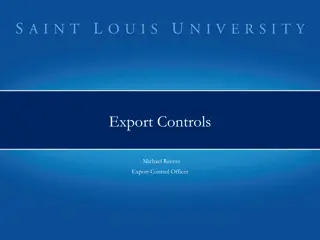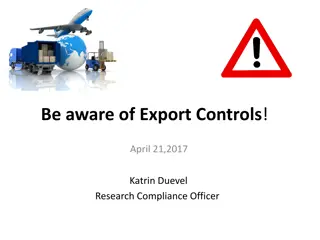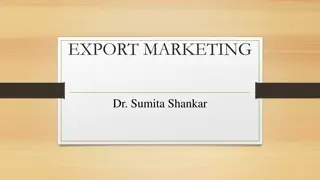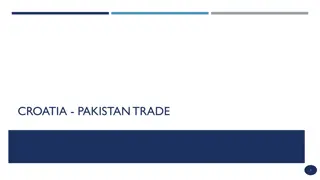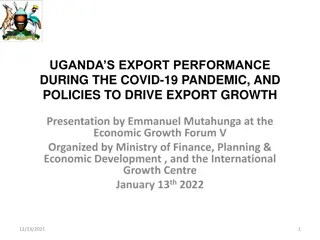Driving Export Growth and Business Resilience in Cheshire and Warrington
Increasing growth ambition and business resilience in Cheshire and Warrington by championing exporting as a route to local business growth. Focusing on inspiring and nurturing an inclusive community of growth-minded exporting businesses to boost local economy resilience. Initiatives include fostering capability development, promoting access to information, and encouraging positive export behaviors.
Download Presentation

Please find below an Image/Link to download the presentation.
The content on the website is provided AS IS for your information and personal use only. It may not be sold, licensed, or shared on other websites without obtaining consent from the author.If you encounter any issues during the download, it is possible that the publisher has removed the file from their server.
You are allowed to download the files provided on this website for personal or commercial use, subject to the condition that they are used lawfully. All files are the property of their respective owners.
The content on the website is provided AS IS for your information and personal use only. It may not be sold, licensed, or shared on other websites without obtaining consent from the author.
E N D
Presentation Transcript
DELIVERING A BETTER FUTURE FOR CHESHIRE AND WARRINGTON
INCREASING THE GROWTH AMBITION AND INCREASING THE GROWTH AMBITION AND RESILIANCE OF OUR BUSINESS COMMUNITY. RESILIANCE OF OUR BUSINESS COMMUNITY. OUR VISION IS T OUR VISION IS TO CHAMPION EXPORTING AS O CHAMPION EXPORTING AS A ROUTE TO LOCAL BUSINESS GROWTH BY A ROUTE TO LOCAL BUSINESS GROWTH BY HARNESSING THE SUPPORT AND EXPERTISE HARNESSING THE SUPPORT AND EXPERTISE OF THE PRIVATE AND PUBLIC SECTOR. OF THE PRIVATE AND PUBLIC SECTOR. EXPORTING: A ROUTE TO BUSINESS GROWTH AND ECONOMIC DEVELOPMENT WE WILL INSPIRE AND NURTURE AN WE WILL INSPIRE AND NURTURE AN INCLUSIVE COMMUNITY OF GROWTH INCLUSIVE COMMUNITY OF GROWTH- - MINDED EXPORTING BUSINESSES NOT ONLY MINDED EXPORTING BUSINESSES NOT ONLY TO INCREASE THEIR OWN RESILIENCE BUT TO INCREASE THEIR OWN RESILIENCE BUT ALSO THAT OF THE LOCAL ECONOMY. ALSO THAT OF THE LOCAL ECONOMY.
CHAMPIONING EXPORTING AS A ROUTE TO GROWTH
INSPIRE & ENCOURAGE Communicate the benefits, raise ambition, encourage development of capability to start exporting or do more. INFORM & CONNECT Promote & facilitate access to correct information, expert advice & practical assistance as well as relevant UK & overseas opportunities, activities, networks & contacts. CHAMPIONING EXPORTING AS A ROUTE TO GROWTH NURTURE & GROW Ensure access to specialist capability development to maximise opportunity (finance, innovation); create local exporter community to share & shape positive export behaviours.
LOW PERCENTAGE OF EXPORTING BUSINESSESS 6% of the C&W LEP-based private sector businesses contribute to 64% of total exports for the region. The 64% of exports stems from within an industry sector that makes up 5% of total business count in the region. LOW VALUE OF EXPORTS AS A PERCENTAGE OF THE REGION S ECONOMY The value of exports represents 35% of the total economy for the region. To achieve the C&W 2040 target exports must achieve a 2.11% year on year growth to sustain this 35%. PREVALENCE OF MICRO AND SMALL BUSINESSES 98% of businesses are under 5m t/o (91% under 1m, 76% under 500k). Small businesses traditionally seek safer growth strategies. 2019 BEIS study on SMEs found over 76% to be growth inclined but only 13% planned growth activities including starting or increasing export sales. THE CURRENT SITUATION Where are we now? (Figures based on 2018 pre-COVID-19 and pre- EU Exit figures) LONG LEAD TIME FOR TRANSITION FROM NEW TO ESTABLISHED EXPORTER 2 years to feel business improvement effects. 3 years for survival rate as an exporter to level off 5 years to transition from new to established exporter.
UK As long as a country is exporting a sufficiently diverse range of products, export-led growth is the favoured model for advanced economies. UK national and sub-national policies reflect this. Recognises 42 high potential sectors for UK businesses. CHESHIRE & WARRINGTON LEP BENEFITS OF EXPORTING FOR ECONOMIC GROWTH Recognises the need to help businesses build quality external relationships to take advantage of growth markets and ensure adequate and suitable investment finance is made available to firms and social enterprises to support their business growth ambitions. Recognises the region as a strong, outward-facing place quoting exports to EU and non-EU countries. Recognises a diverse range of industries with 5 LEP-identified key sectors Export-led Growth Theory: exports boost economic growth by creating employment and increasing labor productivity, by bringing about technological progress, by improving allocation of resources in the economy and by allowing exploitation of economies of scale through expanded market base. In addition exports provide foreign exchange which permits the importation of intermediate goods and technologies which stimulate economic growth. NORTHERN POWERHOUSE A nationally supported region creating its own unique brand to enhance trade and investment prospects on a global stage. NPH has identified 7 pan-northern capabilities which create a distinctive and coherent offer for the North..
BENEFITS Access to more customers; Increased turnover, profitability, productivity and business sustainability; Faster business growth; Improved reputation, credibility and profile; Cooperation with other businesses; Innovation and new product development; Business survival and reduction in risk. CHALLENGES BENEFITS & CHALLENGES OF EXPORTING FOR BUSINESS GROWTH Finding customers; Market knowledge, marketing/product promotion; Foreign exchange rates; Local regulation/standards/licensing; Tarif and/or tax issues; Language and cultural differences; Legal and/or intellectual property issues; Having a suitable product; Competition; Supply chain and/or logistical issues; Knowledge of and accessibility of support; Availability of and affordability of finance. Whilst exporting has been shown to boost the economic growth and resilience of a region or country the links between exporting and improved business performance must be communicated to businesses for them to engage in the conversation. WELCOMED SUPPORT Potential customer contacts; Tax implications; Regulation and customs issues; Market intelligence in terms of demand and competitors; Networking, trade fairs and show-casing events; Marketing issues; Language and cultural issues; Financial support to help with the costs of exporting; Help with developing an export plan; Help with understanding internal capacity to export; International supply chains and distribution channels. The aspirations of business owners may be just as important in explaining the decision to start exporting as more tangible issues.
SMALL & MICRO BUSINESSES In 2018 98% of private sector business in the C&W LEP region were under 5m turnover in size with 91% under 1m turnover and 76% under 500,000. In 2020 the statistics remained similar. SMES: EXPORTING - AN UNTAPPED ROUTE TO GROWTH LOW PERCENTAGE OF SMEs SEE EXPORTING AS A GROWTH ACTIVITY A 2019 BEIS study on SMEs found to be over 76% to be growth inclined but only 13% planned growth activities that included starting or increasing export sales. CORRECTLY ALIGNED SUPPORT and yet winning more customers is seen as a typical route. The C&W LEP Strategic Economic Plan recognises the prevalence of micro and small businesses in the region and as small firms are not merely smaller versions of large corporations the support for business growth must be correctly aligned. This alignment is no less relevant to the support for small businesses with exporting.
SAFER GROWTH STRATEGY SMEs face resource constraints, are more risk averse and seek safer growth strategies. Therefore: Awareness on benefits and risks of exporting is crucial to understand how safe exporting as a growth strategy will be. Enhancing the necessary knowledge and skills within the business is then required to start and continue a successful export journey. EXPORT INTENSITY KEY FACTORS FOR SUCCESSFUL EXPORT PERFORMANCE BY SMEs If resources are limited and ROI on entering new markets is long then focus initially on higher sales and profit from existing markets as success measure.. TIMESCALES 2 years to feel business improvement effects. 3 years for survival rate as an exporter to level off 5 years to transition from new to established exporter. EXPORT PROGRAMMES Many countries introduce export programmes to de- risk exporting as an option for growth. SMEs are supported in understanding and overcoming the challenges of exporting through subsidised upskilling, sharing of expertise, contact building and handholding. UK national programmes tend to focus on: New exporters. Existing exporters entering more difficult markets and/or wishing a more strategic approach. Subsidised assistance for market visits or participation in trade shows.
STAKEHOLDERS LEP County Councils DIT Chambers of Commerce & Industry Business Membership Organisations Education / Development Providers Core Business Services Providers (financial, legal, accounting) Logistics Providers. STAKEHOLDERS & MULTIPLIERS IN C&W LEP REGION MULTIPLIERS Growth Hub Marketing Cheshire DIT NPH Export Champions DIT NW International Trade Advisers Media All stakeholders. THINK BEYOND THE TRADITIONAL Modernise thinking on stakeholders/multipliers. A closer working relationship with e.g. non-exec directors and marketing communications/digital marketing businesses would be modern way to identify businesses looking to grow through exports.
BUSINESS SUPPORT NOT AS HOLISTIC AS IT USED TO BE. EVER-REDUCING TIME FOR HANDHOLDING / CONFIDENCE BUILDING - VALUED BY NEW EXPORTERS AS WELL AS THOSE TACKLING MORE DIFFICULT MARKETS. TAKE AWAY POINTS FROM STAKEHOLDERS AND MULTIPLIERS BAKE IN EXPORTING INTO BUSINESS EDUCATION AT ALL LEVELS. HELP FOSTER NEXT GENERATION EXPORTERS. INSPIRE THEN UPSKILL TO LOOK BEYOND WHAT YOU CAN SEE THEN MAKE THE MILES DISAPPEAR . EMBRACE THE SOFT POWER OF DOING BUSINESS WELL. STAKEHOLDERS/MULTIPLIERS WELCOME CLOSER WORKING RELATIONSHIP WHERE CLIENT JOURNEY CAN BE SHARED.
RECOMMENDATIONS QUANTITY QUANTITY INTENSITY INTENSITY SUSTAINABILITY SUSTAINABILITY FUTURE FUTURE- -PROOFING PROOFING Seek to increase the number of exporting businesses in the Cheshire & Warrington LEP region. This will increase the percentage of businesses contributing to the region s exports. Seek to increase the intensity of exports by businesses in the Cheshire & Warrington LEP region. This will help maintain or increase the percentage contribution by exports to the Cheshire & Warrington LEP economy. Seek to map export support offered within the region and give clear roadmap to businesses. This will increase awareness of available support not only to inspire and assist new and existing exporters but also to reduce export exit by businesses unsure of how to resolve challenges. Seek to incorporate exporting as a means of business growth within businesses and business growth education. This will help bake in the concept of exporting, build the foundation for next generation exporters and build confidence in the choice to export by growth-inclined / growth-ambivalent owner/ managers. Develop and run promotional campaign on benefits of exporting including company- next-door case studies. Track and update on business journeys/C&W export performance. Promote programmes for new exporters. Where lacking, build in local element of handholding /confidence building /access to resources to ensure transition from new to existing exporter (e.g. Virtual Export Manager and Peer-to-Peer networks). Track business journeys and create case studies to inspire others. Whilst being inclusive to all businesses pro- actively seek out clusters of small businesses who are high-skills-level employers offering high value services but not yet exporting. Help develop a structured and supported export journey. Ongoing messages, including case studies, country fact-sheets, stakeholder/peer-to- peer tips on how to get to the next level. Updates on C&W export performance. Promote programmes to assist existing exporters develop a more strategic approach to exporting. Where lacking, build in local element of handholding /confidence building and/or access to resources to overcome internal and external challenges faced at this stage of their growth cycle (e.g. Virtual Export Manager and Peer-to-Peer networks). Track business journeys, create case studies to encourage others. Whilst being inclusive to all businesses pro- actively seek out existing exporters in e.g. clusters or sectors or known exported commodity codes and help develop a structured and supported export journey. Work with stakeholders to collate areas of expertise and export support. Develop a sustainable plan for promotion of and referral to stakeholder support. Review all business education modules and business growth programmes in the region. Discuss with providers ways of incorporating the benefits of exporting and a short introduction to the process of exporting to bake-in exporting as a natural route to business growth.







